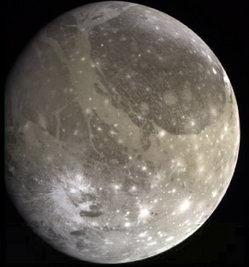Ganymede
This article concerns Ganymede as it relates to Nationstates. For more general information, please see the Wikipedia article on the subject.
| Click image for description | |||||||
| Orbital characteristics | |||||||
|---|---|---|---|---|---|---|---|
| Mean radius | 1,070,400 km (0.007155 AU) | ||||||
| Eccentricity | 0.0011 | ||||||
| Periapsis | 1,069,200 km (0.007147 AU) | ||||||
| Apoapsis | 1,071,600 km (0.007163 AU) | ||||||
| Revolution period | 7.15455296 d (0.019588 a) | ||||||
| Orbital circumference | 6,725,500 km (0.045 AU) | ||||||
| Orbital velocity | max: 10.892 km/s mean: 10.880 km/s min: 10.868 km/s | ||||||
| Inclination | 2.21° (to the ecliptic) 0.20° to Jupiter's equator) | ||||||
| Is a satellite of | Jupiter | ||||||
| Physical characteristics | |||||||
| Mean diameter | 5262.4 km (0.413 Earths) | ||||||
| Surface area | 87 million km2 (0.171 Earths) | ||||||
| Volume | 7.6x1010 km3 (0.0704 Earths) | ||||||
| Mass | 1.4819x1023 kg (0.025 Earths) | ||||||
| Mean density | 1.942 g/cm3 | ||||||
| Surface gravity | 1.43 m/s2 (0.146 g) | ||||||
| Escape velocity | 2.7 km/s | ||||||
| Rotation period | synchronous | ||||||
| Axial tilt | zero | ||||||
| Albedo | 0.43 | ||||||
| Apparent Magnitude | 4.6 | ||||||
| Surface temp. |
| ||||||
| Atmospheric characteristics | |||||||
| Atmospheric pressure | trace | ||||||
| Oxygen | 100% | ||||||
Ganymede is Jupiter's largest natural satellite, greater than even the planet Mercury, although with only half of that planet's mass. It is the largest moon in the Solar System, and is visible from earth with very good eyesight during perfect conditions.
Out of the four nations that first colonized Ganymede, only the Snel now maintain any significant presence on it. In addition to the Snel colony surrounding the south pole, there is a mostly defunct Angstian military installation. Scattered Konanian and Vortex Corporation settlements operate outside of formal national jurisdiction.
Weyrean colonists have recently set up a number of surface and orbital installations, establishing the framework for future Weyrean colonization of Ganymede.

